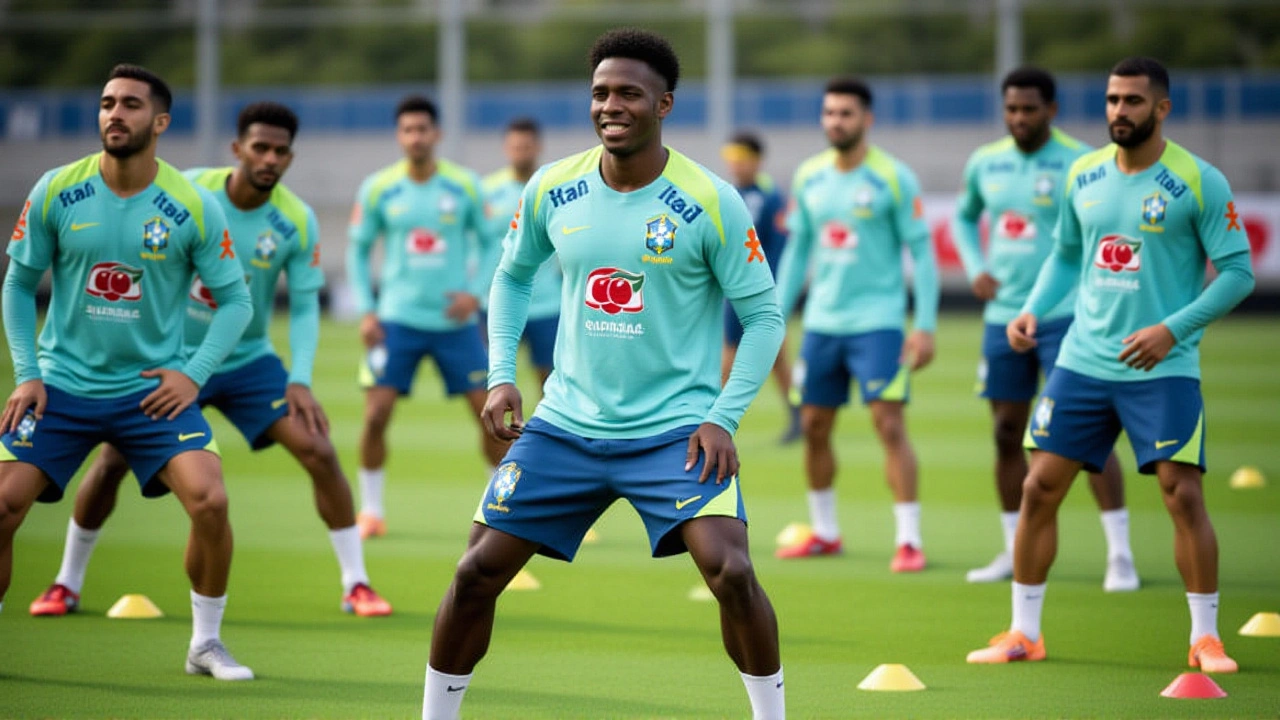When 2026 FIFA World CupNorth America kicks off on June 11, 2026, three co‑hosts – Canada, Mexico and the United States – will already be on the field. The biggest surprise? Japan clinched the very first qualification on March 20, 2024, paving the way for 17 more teams to lock in their tickets by October 2025. FIFA says the tournament will feature 48 squads for the first time, a massive jump from the 32‑team format that has been the norm since 1998. That expansion alone makes the list of qualified nations a story worth following – especially for debutants like Jordan and Uzbekistan.
Who’s In? The 18 Nations That Have Already Qualified
The current roll‑call reads like a world tour of football powerhouses and emerging challengers:
- Canada (host)
- Mexico (host)
- United States (host)
- Japan (AFC)
- New Zealand (OFC)
- Iran (AFC)
- Argentina (CONMEBOL)
- Australia (AFC)
- Uzbekistan (AFC)
- Jordan (AFC)
- South Korea (AFC)
- Morocco (CAF)
- Brazil (CONMEBOL)
- Ecuador (CONMEBOL)
- Uruguay (CONMEBOL)
- Colombia (CONMEBOL)
- Paraguay (CONMEBOL)
- Tunisia (CAF)
That’s a mix of traditional giants, regional leaders, and a few fresh faces. The 2026 edition will be the first time the tournament spans three countries, so the geographic spread of qualified teams feels fitting.
How the Qualification Process Unfolded Across the Six Confederations
It all started on October 12, 2023, when the Asian Football Confederation (AFC) rolled out its first‑round matches. In a quirky footnote, Myanmar’s Lwin Moe Aung netted the inaugural goal of the whole campaign in a 5‑1 rout of Macau – a moment that still makes fans smile.
From there, each confederation followed its own roadmap:
- AFC earned six direct berths. Japan, Iran, Australia, South Korea, Jordan and Uzbekistan claimed them, leaving the inter‑confederation playoff slot still up for grabs.
- CAF (Africa) was allotted nine spots. Morocco and Tunisia have already secured two of those, with the remaining slots contested in upcoming playoffs.
- CONMEBOL (South America) enjoyed six guaranteed places. Argentina, Brazil, Ecuador, Uruguay, Colombia and Paraguay are all set.
- OFC (Oceania) has a single direct slot, which New Zealand claimed after a clean sweep of its regional rivals.
- CONCACAF – besides the three hosts – still has three direct spots and a possible inter‑confederation playoff, but those are still up in the air as of October 2025.
- UEFA (Europe) will finish its marathon in November 2025, with twelve group winners qualifying directly and twelve runners‑up heading into a playoff frenzy.
The British press has been quick to point out the crowded European schedule, noting that double‑headers in June, September and October will test squad depth across the continent.
Debut Nations and Historic Firsts
For Jordan and Uzbekistan, the 2026 World Cup will be a debut on the world’s biggest stage. Both teams secured their spots after navigating a grueling AFC playoff that many pundits labeled “the toughest road to qualification this cycle.”
Even Cape Verde – though not yet qualified – has whispered hopes of joining the debut club, sparking a wave of optimism across West Africa.
In an interview with FIFA, Brazilian legend Bebeto said, “Seeing new faces like Uzbekistan reminds me of when we first broke onto the scene in 1994. It’s a sign of how global the game has become.”

What This Means for the 2026 Tournament
The enlarged 48‑team format means three more groups than in 2022, and a total of 80 matches instead of 64. That translates to more ticket sales, bigger TV rights deals and, crucially, a larger share of revenue for smaller federations.
From a tactical standpoint, coaches will have to manage a tighter schedule. Stian Gregersen, Norway’s defensive stalwart, told FIFA he’s already mapping out how to handle a potential clash with a United States‑hosted quarter‑final – “the travel will be insane, but the atmosphere will be unforgettable,” he noted.
Economists are also watching the North‑American tilt. A study from the University of Toronto predicts the tournament could inject up to $2.3 billion into the Canadian economy alone, thanks to stadium upgrades and tourism spikes.
Looking Ahead: Remaining Slots and the Final European Qualifiers
With 18 nations locked in, 27 slots remain across the six confederations. The biggest unknowns are the CONCACAF play‑offs and the European play‑offs scheduled for November 2025. If history repeats, we can expect a handful of surprise qualifiers – perhaps a Scandinavian side or a Balkan nation that slipped under the radar.
Meanwhile, the host nations are already threading their preparations together. Toronto’s BMO Field is slated for a major expansion, while Mexico City’s Estadio Azteca will undergo seismic retrofitting to meet new safety standards.
All eyes are now on the remaining qualification rounds. As the calendar ticks toward the November deadline, the excitement builds not just for who will fill the final slots, but for how the new format will reshape World Cup football for years to come.
Frequently Asked Questions
How does the expanded 48‑team format affect smaller nations?
With three extra slots, confederations like AFC and CAF gain additional direct places, giving teams such as Jordan and Uzbekistan a realistic chance to qualify without relying on inter‑confederation playoffs. This broader inclusion can boost funding and development programs in those countries.
When will the remaining European qualifiers be decided?
UEFA’s final group stage matches run through September 2025, with the play‑off round set for November 2025. The twelve group winners will earn direct spots, while the twelve runners‑up contest four additional slots via the play‑offs.
What economic impact will the tournament have on the host nations?
Analysts estimate a combined economic boost of roughly $7 billion across Canada, Mexico and the United States, driven by stadium upgrades, hospitality spending and a surge in international tourism during the month‑long event.
Which teams are still fighting for a spot in the 2026 World Cup?
As of October 2025, the open slots include three CONCACAF places (outside the hosts), several CAF spots, an inter‑confederation play‑off slot, and the 12 European play‑off positions. Nations like Haiti, Ghana, and Norway are among those still in contention.
Why was Japan the first to qualify?
Japan secured its spot by topping its AFC qualification group early, thanks to a flawless home‑and‑away record and a decisive 2‑0 win over Saudi Arabia on March 20, 2024 – a match that sealed the tournament’s first ticket.

Ellen Ross
October 15, 2025 AT 00:39Japan's early clinch is less a sports milestone than a subtle reminder that the global order flexes with each decisive 90‑minute battle; the Samurai’s precision mirrors a disciplined bureaucracy that refuses to yield to the chaotic whims of fate, and it forces us to reckon with the silent contracts that bind nations to the myth of meritocracy – a myth that crumbles whenever a well‑timed counter‑attack rewrites destiny. In that sense the qualification is a micro‑cosm of power dynamics that stretch beyond the pitch, exposing how cultural capital translates into geopolitical leverage, and we should all feel the reverberations deep within our own civic consciousness. This isn’t just a tournament; it’s a case study in how disciplined execution can outmaneuver systemic inequities, whether you notice it or not.
Fabian Rademacher
October 16, 2025 AT 04:33There's a hidden agenda behind the North American trio, the same elite cabal that wants to funnel billions into stadium deals while keeping fans distracted with flashier nations like Japan, and anyone who thinks it's all about sport is buying the lie. The timing of Japan's qualification lines up perfectly with the lobbying cycles in Ottawa and Washington, suggesting a coordinated narrative to legitimize the massive infrastructure push. Wake up, folks.
Terrell Mack
October 17, 2025 AT 08:28Love seeing the variety this time around – more chances for underdogs to shine and the hosts getting a real boost. From a coaching perspective, the expanded format means we can rotate squads without sacrificing quality, which should keep the games fresh all the way to the finals. Can't wait to see how the new groups play out.
Dawn Waller
October 18, 2025 AT 12:23Oh, marvelous,, Japan snatches the first ticket like it's some grandiose prophecy,, and here we are, merely mortals, scrambling to keep up with the *so‑called* “global expansion” of the beautiful game,, isn’t it just delightful?? The whole spectacle feels like an over‑cooked sushi roll – all flash, little substance,, but hey, at least it’s Instagram‑ready!!
Grace Melville
October 19, 2025 AT 16:18Great to see more spots for emerging teams 😊
Ashlynn Barbery
October 20, 2025 AT 20:13Indeed, the inclusion of nations such as Jordan and Uzbekistan reflects a commendable commitment to global development within the sport. This progression not only enhances competitive diversity but also fosters broader cultural exchange, which aligns with the overarching objectives of FIFA’s expanded format.
Sarah Graham
October 22, 2025 AT 00:08Appreciate the balanced approach; looking forward to seeing fresh talent emerge.
Jauregui Genoveva
October 23, 2025 AT 04:03Only time will tell if this hype is justified 🤷♀️
Quinten Squires
October 24, 2025 AT 07:58Honestly the whole qualification saga is a masterclass in strategic planning teams adapt and overcome obstacles yet the media skips over the nuanced tactics that actually decide these matches
Tyler Manning
October 25, 2025 AT 11:53The United States stands poised to host a World Cup unprecedented in scale, a testament to American organizational superiority.
Our infrastructures, from stadiums to transportation corridors, dwarf those of any competing nation and will set new standards for future tournaments.
It is imperative that we recognize this event as a victory for not only sport but also for the affirmation of democratic values on the global stage.
The inclusion of an expanded 48‑team roster showcases FIFA’s willingness to accommodate diverse footballing cultures, yet it also serves as a platform for showcasing the might of North American hospitality.
While Japan’s early qualification is noteworthy, it must be contextualized within a broader narrative of Asian football’s rising commercial ambitions.
The United States, by contrast, offers a market unparalleled in consumer power and media reach, which will inevitably elevate the tournament’s profile.
The logistical challenges of a tri‑national host model are mitigated by our advanced technological infrastructure, ensuring seamless broadcast and fan experiences.
Moreover, the economic influx predicted by independent analysts will reinforce the United States’ position as a premier sporting destination.
This financial boon will cascade into grassroots development programs, thereby strengthening the domestic talent pipeline for future generations.
It is also crucial to acknowledge that the forthcoming qualifiers across other confederations will be subjected to heightened scrutiny, as any perceived imbalance could be interpreted as a challenge to the North American hegemony in this sport.
The United States remains steadfast in its commitment to upholding the integrity of competition, and any allegations of favoritism will be met with transparent oversight mechanisms.
The expanded format also affords smaller nations the opportunity to experience the grandeur of a world‑class tournament, a gesture that aligns with FIFA’s professed inclusivity.
Nonetheless, the responsibility to maintain high standards of play rests primarily with the host nations, whose venues must meet rigorous criteria.
In this regard, the United States’ track record of delivering flawless major events-such as the 2024 Summer Olympics-serves as a compelling precedent.
Ultimately, the 2026 World Cup will be remembered not only for its competitive drama but also for the exemplary execution orchestrated by the United States, a legacy that will endure for decades.
james patel
October 26, 2025 AT 14:48The qualification pipeline leverages inter‑confederation play‑offs as a stochastic variable within the allocation matrix, thereby optimizing berth distribution efficiency across FIFA’s competitive hierarchy.
Scarlett Mirage
October 27, 2025 AT 18:43One must consider the epistemological ramifications of labeling certain nations as “debutants”, for such terminology inadvertently reinforces archaic hierarchies,, and while the intent may be celebratory,, the execution borders on patronizing,, don’t you think??
Ian Sepp
October 28, 2025 AT 22:38In summary, the current qualification landscape reflects a multifaceted interplay of sporting merit, economic considerations, and geopolitical dynamics, all of which will shape the forthcoming tournament.